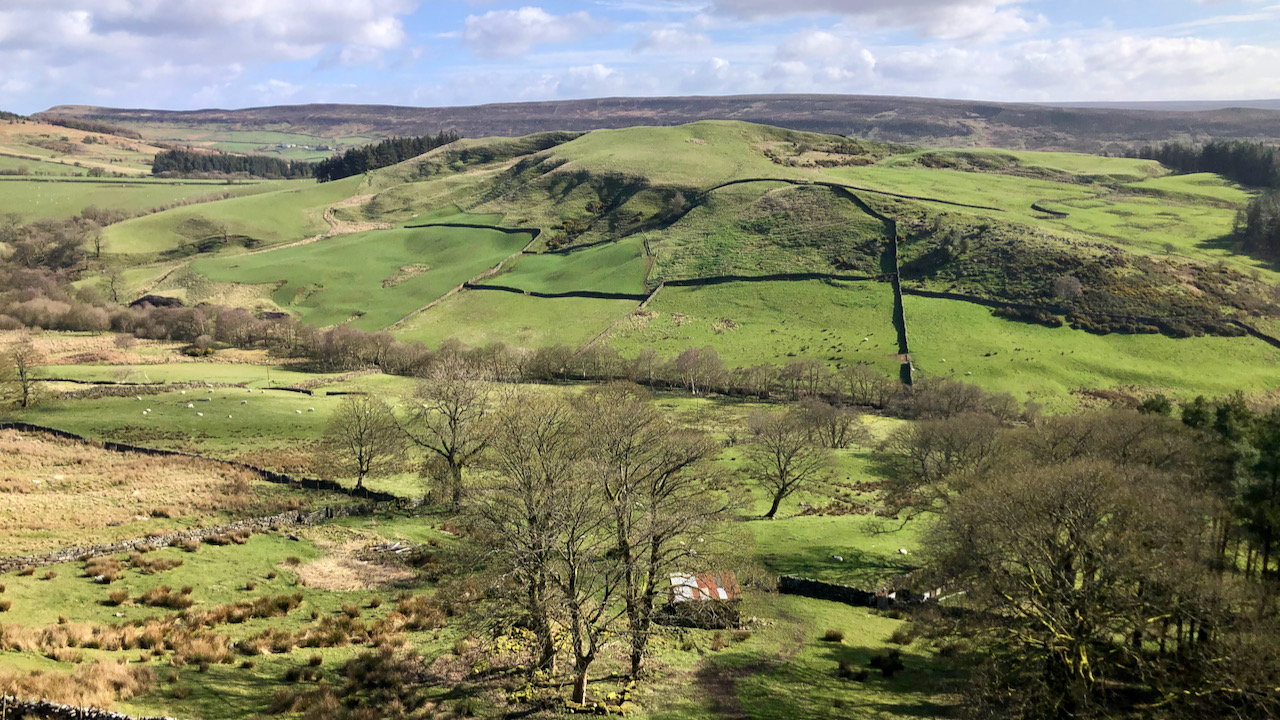A view of Wath Hill from above the remains of the old farmstead of Clough.
Just a handful of moss-covered stones indicate where Clough House farm used to stand. It’s simple to overlook its past as a bustling farm, a family home. A solitary out-building still stands, its roof clad in corrugated sheeting. The rest of the stone from Clough was used in the building of the Chop Gate village hall1Farmstead at Clough NYMNPA HER No: 10625.
In 1781, William Hunton called this place home, followed by John Garbutt, who tended thirty-five acres in 18262Bilsdale Survey, 1781. ‘Local History Articles’, Bilsdale.org.uk <https://www.bilsdale.org.uk/history/article/28/> [accessed 22 March 2024].
John Garbutt remained at Clough during the 1841 census. At 45 years old, he dwelt with his wife Hannah, aged 43, alongside two stepsons, Thomas Bell, aged 7, and Garbutt Bell, aged 14. Also living on the farm was Maria Souter, a 15-year-old agriculture labourer3“Bilsdale Population Census PDF Free Download.” Docplayer.net, 2014, docplayer.net/53383947-Bilsdale-population-census-1841.html. Accessed 3 Apr. 2021..
Curiously, a family history found online, which has since vanished, informed us that a Sarah Bell was born at Clough in 1816 and remained a resident until her wedding 23 years later. Alas, the webpage is now beyond reach 4“THOMAS WOOD – SARAH BELL.” Ecwood.co.uk, 2021, www.ecwood.co.uk/LatestBK/f25.html. Accessed 3 Apr. 2021. Site no longer live..
It was all change by the next census, 1851. ‘Cloorf‘ was then occupied by Robert Worthy, his wife Mary, and son William5Lost Farms Bygone Bilsdale Review. [n.d.]. <https://www.bilsdale.org.uk/assets/files/lostfarms_sources.pdf> [accessed 22 March 2024].
The exact date Clough House was left to the elements remains a mystery, but come 1950, it was a sorry sight, abandoned and falling apart. They began improving the neglected fields around that time. Clough wasn’t the only one facing such a fate — farms all over had been left to fend for themselves since the late 1800s. Even if some patches of land still saw use, those high-up fields were often too poor in quality to bother with. Then came World War II, and the government stepped in, aiming to make the most of marginal land for livestock. Neglected pastures like Clough House got ploughed and improved into better grazing pasture. Their mission was clear: reclaim what’s there, not improve new moorland6Farra, Margaret, “A STUDY OF THE LAND-USE CHANGES OF THE NORTH YORK MOORS”. ProQuest Number 10097250. ProQuest LLC(2016) Page 256.
- 1Farmstead at Clough NYMNPA HER No: 10625
- 2Bilsdale Survey, 1781. ‘Local History Articles’, Bilsdale.org.uk <https://www.bilsdale.org.uk/history/article/28/> [accessed 22 March 2024]
- 3“Bilsdale Population Census PDF Free Download.” Docplayer.net, 2014, docplayer.net/53383947-Bilsdale-population-census-1841.html. Accessed 3 Apr. 2021.
- 4“THOMAS WOOD – SARAH BELL.” Ecwood.co.uk, 2021, www.ecwood.co.uk/LatestBK/f25.html. Accessed 3 Apr. 2021. Site no longer live.
- 5Lost Farms Bygone Bilsdale Review. [n.d.]. <https://www.bilsdale.org.uk/assets/files/lostfarms_sources.pdf> [accessed 22 March 2024]
- 6Farra, Margaret, “A STUDY OF THE LAND-USE CHANGES OF THE NORTH YORK MOORS”. ProQuest Number 10097250. ProQuest LLC(2016) Page 256

Leave a Reply